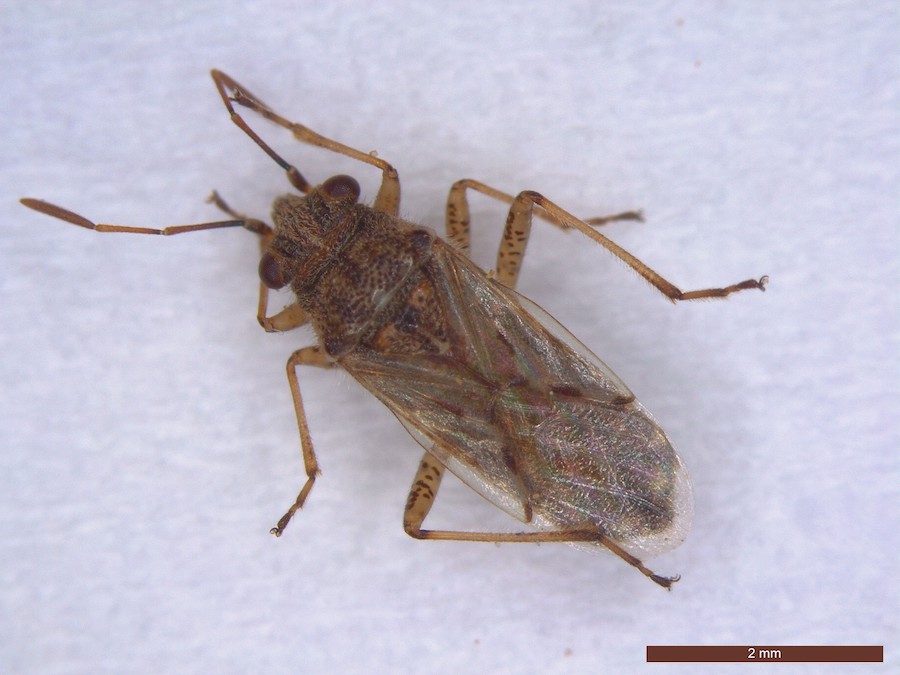The northern region’s biggest summer crop bugbear, the sporadic but particularly challenging Rutherglen bug (RGB), is the focus of a new GRDC-supported, CSIRO-led project.
The project is in response to RGB being identified by agronomists as one of the highest priority pests in summer cropping systems.
The project’s leader, CSIRO researcher Hazel Parry, says the native pest has a “taste for the exotic”. Although it breeds on a range of native hosts, recent work by Dr Parry and her colleagues shows it also has a broad taste. This includes weeds, such as fleabane (Conyza sp.) – where the juvenile stages are commonly found – grasses and, unfortunately, numerous grain crops.
The small, fast-moving bug builds up to high numbers during the warmer months and, if it gathers on seedlings, the feeding can result in plant dehydration and death.
However, while the pest may be resident on weeds throughout the year, it is RGB’s sudden appearance in crops that can cause problems. Very little is known about what may cause mass movement and outbreaks.
GRDC Crop Protection Manager (North) Vicki Green says that RGB is often seen in canola crops in small numbers “just poking along”.
“But then in some seasons they exhibit a synchronised emergence from canola, and exit en masse, causing significant damage to adjacent early season summer crops. In other situations, sorghum crops in grain fill can be swamped by RGB. We want to know what causes this. What are the triggers and why, in some seasons, crops are inundated by wave after wave of them?”
These and other questions will be explored by Dr Parry and her CSIRO colleagues Dr Matt Hill and Andy Hulthen. They will work with genetics researchers Dr James Hereward and Dr Dean Brookes from the University of Queensland and a team of field officers led by Dr Zorica Duric from the NSW Department of Primary Industries (DPI) over the next two years.
Dr Parry says the project aims to understand the factors that drive the pest’s persistence and predict the likely incidence of damaging populations. The work will build on previous GRDC-funded research to understand the environmental and vegetative drivers of RGB emergence, development and dispersal.

A concerted research effort led by CSIRO aims to reduce Rutherglen bug’s damaging effects on crops in the Northern Region. Photo: Supplied by Zorica Duric
The researchers will focus on understanding why populations persist in the local environment, update management guidelines to minimise the effects of early and late-season infestations and provide a risk framework to predict likely infestation from both locally emerged and migratory populations.
“We want to know where do RGB arriving in a summer crop come from? Why have outbreaks increased in size, frequency and impact in the last decade? What is the emergence behaviour of RGB from different habitats within a landscape? And how do RGB population dynamics relate to environmental drivers or key hosts?” Dr Parry says.
History
Until 2007, RGB was not considered a major sorghum pest. However, that year extremely high infestations in early sorghum crops resulted in damage. A decade later, in the 2016-17 season, RGB populations were extremely high and persisted in crops for weeks. As a result, RGB is one of the northern region’s biggest pest priorities for summer crops.
Dr Parry’s team aims to fill in research gaps. Already, in addition to understanding the key plant hosts, her work has explored what drives flight initiation, such as temperature, food and water availability, and sex and mating status.
For example, her laboratory experiments have found that:
- the optimal temperature for flight is 25°C. Yet, if an extreme temperature event occurs – at 35°C or hotter – a mass take-off is likely;
- regardless of food and water availability, individuals of both sexes are much more likely to take off once mated; and
- as the availability of food and water decreases, the tendency to take off increases. Similarly, a lack of resources is also amplified when temperatures become more favourable for flight.
Taking this knowledge further, flight initiation modelling has given insight into regional differences in insect dispersal. Dr Parry says extreme temperatures above 35°C, coupled with drought, may instigate mass dispersal into irrigated crops.
“Being able to link movement and environmental drivers, such as wind, is useful for crop management. It could be used in integrated pest management strategies to monitor for RGB arrival, help consider whether early season weed removal is worthwhile to prevent population build-up, and help understand when best to spray if it is already in the crop.”
Dr Parry and the team will also be asking agronomists and consultants to take part in RGB monitoring. “We want to be provided with outbreak sightings and genetic samples too. The community’s help will be an important part of the work.”
More information: Hazel Parry, hazel.parry@csiro.au; CSIRO's Improved management of Rutherglen bug in the Northern region.

























































